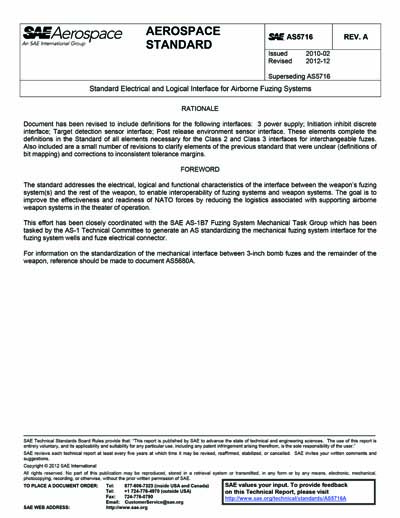Most recent
SAE AS 5716A-2012 (SAE AS5716A-2012)
Standard Electrical and Logical Interface for Airborne Fuzing Systems
This interface standard applies to fuzes/fuzing systems (referred to as fuzing system hereafter) in airborne weapons that use a MIL-STD-1760 type interface. It defines the powers, the discrete signals and the serial data interface for the communications at the interface between the fuzing system and the remainder of the weapon, including the weapon control unit.
The Class 1 interface is an electrical only interface that facilitates use of MIL-STD-1760 type platform store interfaces for the fuze to monitor intentional release and defines the fuze interface bus communications protocol to allow sending and receiving data from fuzing systems.
Class 2 interfaces add a defined connector and additional interfaces to facilitate the exchange of compatible fuzing systems.
Class 3 interfaces add further interface definitions to facilitate the exchange of AS5680A compatible fuzing systems components.
The bus communications protocol provides a means by which the weapon may set mission parameters within the fuzing system main housing and in other devices external to the fuzing system main housing. The standard also defines the target detection signal to be provided by a target detection device external to the fuzing system.
This standard does not address the mechanical interfaces to target detection devices or to other sensors that are external to the fuzing system main housing.
CAUTION: The user of this standard should be aware that the weapon and the fuzing system will need to be evaluated against and comply with all applicable safety standards. It should be noted that the fuzing system safety boundary may encompass the entire weapon system
CAUTION: This version of AS5716A includes definitions of Class 2 and Class 3 interfaces to support the fuzing system interchangeability requested by NATO. Class 2 and Class 3 compliant weapons and fuzing systems allow the use of compliant multiple fuzing systems with a weapon and vice versa. As a consequence, the user has to implement the necessary procedures or design features to prevent the assembly of unsuitable fuzes or PRES into the weapon in order to ensure safety and full functionality (e.g., the minimum arm times allowed by a specific fuzing system fuze may be less than that required by a weapon system to ensure adequate safety, or a specific PRES may be mounted into the wrong weapon, thus incorrectly sensing the arming environment as being met). Weapon and fuzing system designers will need to address the interchangeability issue with measures1 that are beyond the scope of this interface standard in order to satisfy safety standards. This version of AS5716A includes the definition of a Class 3 interface to further support the fuzing system interchangeability requested by NATO. Class 3 interfaces include a standardized interface to a post release environment sensor (PRES) and allow for this element of the safe and arming functionality of the fuzing system to be permanently incorporated with the weapon system. Subclasses of the Class 3 interface are then intended to electrically and logically discriminate between different PRES technologies and environmental sensor techniques. This approach permits a PRES (and associated weapon system) to be used with multiple fuzing systems, and a fuzing system to be used with multiple PRES types (i.e., multiple weapon systems). As a consequence it is possible to use combinations of fuzing systems and PRES which may not be compatible, thus potentially resulting in a hazardous condition or a degraded capability and reliability. Specifically subclass A1 of Class 3 defines a simple analog interface for post release air speed sensors with no digital safeguards. This provides a significant risk of unintended and untested combinations of fuzing systems, PRES and weapon to be physically connected in the field, causing a potential safety hazard. For fuzing systems belonging to or being compatible with Class 3, subclass A1, the user has to solely rely on procedures in the field to prevent hazards due to incompatible combinations of fuzing systems, PRES and weapons and to ensure full functionality. The use of Class 3, subclass A1, interfaces therefore is strongly discouraged.
Content Provider
Society of Automotive Engineers [sae]






